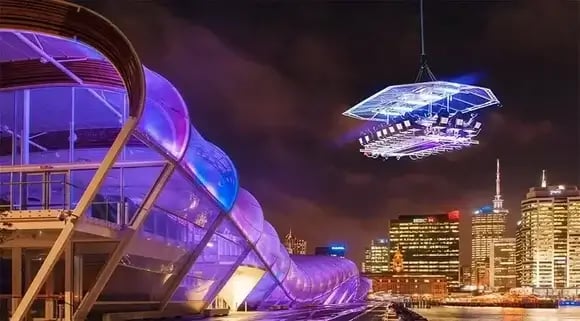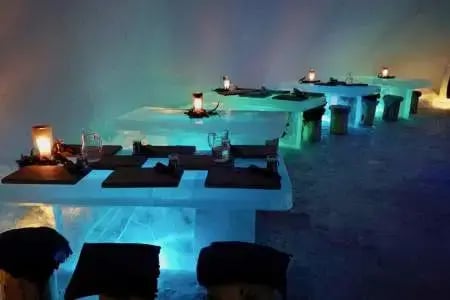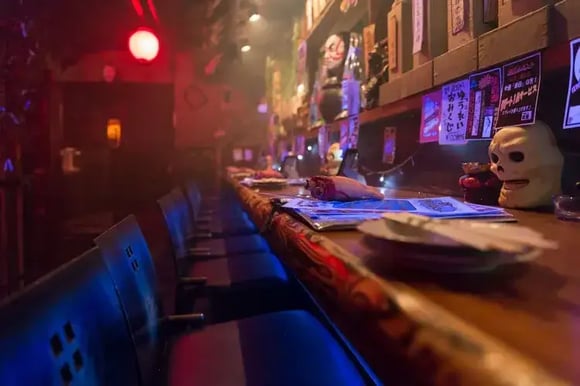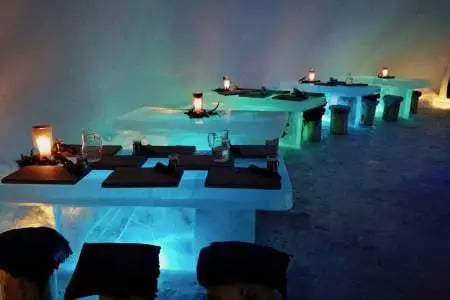Every successful restaurant starts with a strong idea. If you get it right, you'll get great reviews, recommendations, and loyal customers. If you miss the mark, with a menu that doesn't fit the atmosphere or prices that don't match the customers, you might lose potential regulars.
Starting a restaurant isn't easy, and even experienced owners don't always get it right the first time. But with some help and inspiration, you can boost your creativity. Here are fifteen successful restaurant ideas to inspire and guide you when opening your restaurant.
What is the restaurant concept?
A restaurant concept is the foundation of a restaurant's identity, design, menu, culture, and overall experience. It includes the different elements that make the restaurant unique and stand out from competitors. Overall, a clear restaurant concept helps attract a specific group of customers and creates a memorable dining experience.
Comment
byu/badfish2883 from discussion
inrestaurant
15 examples of unique restaurant concepts
- Super Intimate
- Circus Show
- Dark Dining
- Tables in the Sky
- Opera with Dinner
- High Altitude Dining
- Under The Sea
- Ice and Snow
- TreeTop
- Terrifying Eats
- In a Prison
- Restaurant Run By Children
- Airplane Dining
- A Single Dish
- No Menu Dining
1. Super intimate
Securing a reservation at a popular restaurant often makes the occasion feel extra special. Diners enjoy a sense of exclusivity from successfully booking a table.
But what if, instead of many tables, you served just one or two groups at a time? The super cozy restaurant is a concept you might encounter occasionally. Many diners complain about being packed too tightly in busy restaurants, where profit comes first.

Solo Per Due in central Italy claims to be the smallest restaurant in the world. With just one small dining room, it sits just two diners at a time.
Pros
- Guests feel special and valued.
- Staff can offer more attentive service.
- Ideal for special occasions.
- Chefs can perfect each dish.
- Differentiates from competitors.
Cons
- Less revenue per night.
- Expensive to maintain quality and service.
- Long waiting lists can frustrate customers.
- Hard to justify full staff for a few tables.
- Difficult to expand without losing intimacy.
2. Circus show
Entertainment and dining have long gone hand in hand as a concept. But while some restaurants have jazz musicians or pianists playing, there are others that choose to wow diners with acrobatics and brave feats such as fire breathing, as well as the quality of their food.
Circus in London is a circus-themed restaurant where guests can enjoy cocktails, food, and a show. It offers a sharing menu for groups of five or more along with a tasting menu and a la carte options.
Pros
- Offers a one-of-a-kind dining experience.
- Creates a lively and exciting ambiance.
- Provides entertainment beyond food.
- Attracts customers willing to spend.
- Sets the restaurant apart from others.
Cons
- Entertainment acts can be expensive.
- Coordinating entertainment with dining service.
- Not everyone may enjoy the circus theme.
- Focus on entertainment over food.
- Acts like fire breathing may pose safety risks.
Further reading
Dark dining
The presentation has become a huge aspect of fine dining marketing. But would the food on your plate taste better if you couldn’t see it? The loss of one sense is said to heighten the other senses and thus intensify food’s flavors.
This is the primary concept behind dine-in-the-dark restaurants. Over the last few decades, a number of such restaurants have opened up across the globe, though the very first is said to have launched in Paris in the early 1990s.
The wait staff at these eateries are often visually impaired or are specially trained to provide service in the dark.
Dans le Noir is an international dining-in-the-dark chain open in cities from Paris to St Petersburg.
Dark dining is a sensory journey that challenges diners to rely on taste, smell, touch, and sound, rather than sight, to experience food in a whole new way. It's a unique and immersive dining adventure that encourages guests to step out of their comfort zones and truly savor each flavor and texture, creating a memorable and enlightening culinary experience.
Pros
- Loss of sight intensifies taste and other senses.
- Memorable and novel for diners.
- Removes distractions, allowing focus on taste and texture.
- Provides employment for visually impaired individuals.
Cons
- Not everyone enjoys dining in complete darkness.
- Moving and eating in the dark can be risky.
- Lack of visual cues makes communication difficult.
- Some diners may feel disoriented or anxious.
Tables in the sky
Restaurateurs love to play with diners’ senses or to provide some kind of spectacle. And dining in the sky at a table suspended high in the air certainly promises both.
Along with a sense of danger, visiting such eateries usually has a touch of exclusivity, as it’s simply not possible to suspend a huge number of diners in the sky at once.

You’ll find dining in the sky restaurants all over the world, including the 45 countries where the dinner in the sky chain operates.
Pros
- Offers a thrilling and memorable dining adventure.
- Provides breathtaking scenery from high above.
- Limited seating adds a touch of exclusivity.
- Attracts those seeking excitement and novelty.
Cons
- Expensive to set up and maintain.
- Fewer diners can be accommodated at a time.
- Potential risks involved with dining at high altitudes.
- Experience can be affected by weather conditions.
Opera with dinner
You’ve heard of a pre-theatre menu, right? Why not cut out a journey and save some time by serving up opera alongside the dinner menu?
A number of restaurants choose to provide aural entertainment for their diners but there’s also the option to drive up to an open-air opera show and enjoy dinner in your car. Is it the perfect mix of culture and convenience?
The Santa Fe Opera offers a unique opera tailgating dining option.
Pros
- Combines fine dining with live opera for a rich, cultural experience.
- Saves time by offering entertainment and dining in one place.
- Creates a sophisticated and memorable dining environment.
- Attracts guests who appreciate both fine dining and opera.
Cons
- More expensive to provide live opera performances.
- Not everyone enjoys opera, which may limit the customer base.
- Music can distract some diners from their meals.
- Coordinating performances with dining service can be complex.
High altitude eating
Dinner with a view can make eating out an even more special experience, and some of the eateries located at high altitude spots across the globe certainly boast a good vista. Fine dining and fine views frequently go hand-in-hand to cement a premium dining experience.
The highest restaurant in the world At.mosphere is located on the 122nd floor of the world’s largest building, the Burj Khalifa in Dubai.
Pros
- Breathtaking scenery enhances the dining experience.
- Creates a memorable and exclusive setting.
- Combines fine dining with stunning vistas.
- Attracts tourists and luxury seekers.
Cons
- Expensive to operate and maintain.
- May be difficult for some guests to reach.
- Experience can be affected by weather.
- Some may be uncomfortable with the height.
Under the sea
You may find that you want to skip the fish course if you’re lucky enough to dine at an under-the-sea restaurant.
A handful of partially or fully submerged eateries are located across the globe and a new venture – the first in Europe – is due to open in Norway in 2019. Expect to be wowed by marine life swim by, above, or around you.
5.8 Undersea Restaurant in the Maldives is an all-glass underwater restaurant with a totally unique view.
Pros
- Offers a one-of-a-kind dining adventure with marine life views.
- Creates an unforgettable and immersive setting.
- Provides stunning, up-close views of underwater life.
- Attracts diners seeking novelty and excitement.
Cons
- Expensive to build, maintain, and operate.
- Limited locations make it less accessible for many diners.
- Some patrons may feel uneasy or claustrophobic.
- Construction and operation could impact marine ecosystems.
Ice and snow
Ice-themed restaurants have popped up in some surprising locations across the globe. You might expect to encounter them in the Arctic Circle, for example, and you can certainly book ice-dining experiences if you choose to visit the region.
You can also find ice-themed dining options in less obvious places like Dubai, taking the ‘chill-out’ factor of eating out to new levels.

The Northern Lights Village’s Ice Bar & Restaurant in Saariselkä offers traditional Arctic Circle delicacies in a restaurant made from snow and ice.
Pros
- Offers a novelty dining adventure in an ice-themed setting.
- Creates a cool and unforgettable environment.
- Attracts diners looking for a unique and exciting experience.
- Available in surprising places, not just cold regions.
Cons
- Expensive to build, maintain, and operate.
- Cold temperatures may be uncomfortable for some diners.
- Not everyone may enjoy the icy setting.
- Can only be practical in certain seasons or climates.
Treetop
Got a head for heights? Maybe you’re a fan of foliage? Treehouse restaurants can be found in countries with a diverse range of climates.
Eating among the branches is a great way to appreciate the spectacle of nature around you while enjoying a bite to eat. However, some eateries go above and beyond to provide a dining experience that’s out of the ordinary.
Treepod dining at Soneva Kiri features service from the zip-lining wait staff.
Pros
- Offers a one-of-a-kind dining adventure among the trees.
- Provides stunning views of nature and foliage.
- Creates an unforgettable and immersive environment.
- Attracts diners seeking novelty and excitement.
- Often integrates sustainable and natural elements.
Cons
- Expensive to build, maintain, and operate.
- Can be difficult for some guests to reach due to height or location.
- Dining experience can be affected by weather conditions.
- Potential risks involved with elevated dining and zip-lining service.
Terrifying eats
Being served undercooked chicken or enduring a two-hour wait between courses would definitely qualify you as having a horrific dining experience, but if you’re a horror fan, there are truly some scarier eateries out there!
From haunted houses to ghoulish wait staff, there are some truly terrifying dining options.

Yurei is an underground ghost-themed restaurant in Tokyo with a fun, spooky atmosphere.
Pros
- Offers a thrilling and memorable dining adventure.
- Attracts horror fans and thrill-seekers.
- Creates an exciting and engaging environment.
- Provides a fun and unique topic for diners to discuss.
- Great for theme parties and Halloween events.
Cons
- Not everyone enjoys a scary dining experience.
- Some patrons may feel genuinely frightened or uneasy.
- Expensive to create and maintain a convincing horror atmosphere.
- Can only attract a specific group of customers.
In a prison
There’s no doubt that working in a restaurant can be stressful but it can also be very satisfying, cooking itself is considered by many to be a therapeutic activity. It’s perhaps no surprise therefore that a number of restaurants around the world run their own prisoner rehabilitation schemes.
Attached to or actually, inside prisons, some of these restaurants have won awards for their quality of food and service and provide training that is said to reduce re-offending records.
The Clink Charity runs several prison restaurants in the UK.
Pros
- Helps prisoners gain valuable skills and reduce re-offending rates.
- Some prison restaurants are award-winning for their food and service.
- Supports prisoner rehabilitation and reintegration into society.
- Offers diners a one-of-a-kind and thought-provoking dining adventure.
Cons
- Not everyone may feel comfortable dining in a prison setting.
- Potential safety issues with the restaurant being inside or attached to a prison.
- Some diners may have reservations about the concept.
- Managing a restaurant within a prison can be complex and demanding.
Restaurant run by children
Do your little ones like to help out in the kitchen? How do you think they’d cope with waiting on customers? A restaurant run by children may seem like a place ripe for chaos and tantrums, but it does actually exist!
Kinderkookkafe is a restaurant in the Netherlands run by children in a childcare setting. The kids prepare and cook the food under supervision, wait on tables, and take the bill to diners as part of a learning experience. As you’d expect, the diners are usually their very proud parents.
Pros
- Offers a charming and memorable dining adventure.
- Provides children with practical skills in cooking and customer service.
- Creates a fun and supportive environment for kids and their families.
- Encourages a sense of accomplishment and teamwork among the children.
Cons
- Can primarily attract families with children.
- Consistency in food quality and service may vary.
- Needs constant adult supervision for safety and guidance.
- Managing a restaurant run by children can be complex and unpredictable.
Airplane dining
It gets bad press but in-flight dining has come a long way in recent years. And of course, airplane dinners are part and parcel of exciting journeys. But how would you feel about dining in an airplane that never leaves the ground? Aviation enthusiasts in particular are likely diners at airplane-themed establishments.
The Airplane Restaurant in Colorado Springs, United States calls a Boeing KC-97 tanker home and features an aviation-themed casual dining menu.
Pros
- Offers a novel and memorable dining adventure in an airplane setting.
- Attracts aviation enthusiasts and those looking for a unique dining environment.
- Provides an interesting topic for diners to discuss.
- Appeals to those with fond memories of air travel.
Cons
- Not everyone may enjoy the airplane theme.
- Airplane interiors can be cramped and limit comfort.
- Maintaining an airplane-themed restaurant can be expensive.
- The novelty may wear off quickly for some diners.
A single dish
Spend your daydreaming about the best-ever bowl of cereal. Can’t get enough cheese?
As a restaurant, it’s great to have a signature dish or to be known for a particular section of your menu but some chefs narrow the field even further and focus on just one single dish or ingredient. And the novelty of such concepts means that such eateries can prove very popular indeed.
The Cereal Killer Café is a small but global chain of cereal specialists who recently added savory and alcoholic options to the menu at their London branches.
Pros
- Allows chefs to perfect one dish or ingredient, ensuring high quality.
- Offers a novel and memorable dining experience.
- Easier to market and attract customers interested in the specialty.
- Simplifies operations and reduces inventory costs.
Cons
- Can not attract diners looking for variety.
- Popularity may decline once the novelty wears off.
- Regular customers can get bored with limited options.
No menu dining
Want your kitchen staff to be able to concentrate on serving up the finest locally sourced and seasonal ingredients without being bound to a regular menu? No-menu dining is certainly no new thing. In fact, the restaurants choosing to adopt this concept are harking back to days gone by.
Diners enjoy the surprise of being served whatever comes out of the kitchen and the chef is free to make the most of what is available. Plus, the customers don’t need to worry about not being able to choose what to eat. It’s like a Prix Fixe with a bigger element of surprise!
Chinese restaurant Hunan in London is one such restaurant known for its no-menu approach.
Pros
- Focuses on the finest locally sourced and seasonal ingredients.
- Allows chefs the freedom to create unique and spontaneous dishes.
- Offers diners an exciting and adventurous dining experience.
- Reduces the complexity of maintaining a fixed menu.
Cons
- Diners cannot choose their dishes, which may not suit everyone.
- More difficult to accommodate dietary restrictions and personal preferences.
- Quality and consistency may vary based on ingredient availability.
Key takeaways
Exploring unique dining concepts, from dining in the dark to high altitude and treetop experiences, showcases the creativity and innovation in the restaurant industry. These unconventional eateries offer memorable and often thrilling experiences that go beyond the traditional dining setting. While each concept comes with its own set of pros and cons, they all share the goal of providing a distinctive and engaging experience for diners.
Whether it’s the thrill of a high-flying meal, the charm of dining among the trees, or the surprise of a no-menu dinner, these unique concepts cater to a variety of tastes and preferences. They also highlight the importance of thinking outside the box to create unforgettable dining adventures. As the culinary world continues to evolve, we can expect even more inventive and exciting dining experiences to emerge, each with its own appeal and challenges.














.webp?width=200&name=v2-15mknc-qpw1b%20(1).webp)
.webp?width=200&name=v2-15kqni-p0exl%20(1).webp)
-1.png?width=1812&height=1072&name=TripAdvisor%20%26%20More%20Bookings%20(1)-1.png)
-2.png?width=1812&height=1072&name=Google%20Bookings%20(1)-2.png)


-1.png?width=200&name=TripAdvisor%20%26%20More%20Bookings%20(1)-1.png)
-2.png?width=200&name=Google%20Bookings%20(1)-2.png)
-1.png?width=200&name=Instagram%20Bookings%20(1)-1.png)
-1-png.webp?width=200&name=Facebook%20Integration%20Rectangle%20(1)-1-png.webp)







.webp?width=200&name=download%20(1).webp)
%20(1)-2.webp?width=200&name=Eat%20(34)%20(1)-2.webp)
%20(1)-2.webp?width=200&name=Eat%20(18)%20(1)-2.webp)






%20(1)-1.webp?width=314&height=175&name=Eat%20(45)%20(1)-1.webp)
%20(1).webp?width=314&height=175&name=Eat%20(53)%20(1).webp)
.webp?width=314&height=175&name=image19%20(1).webp)
%20(1).webp?width=314&height=175&name=Eat%20(66)%20(1).webp)


.webp?width=144&height=72&name=Eat%20App%20Logo%20(3).webp)